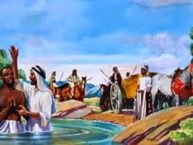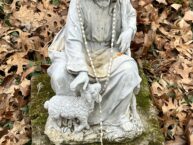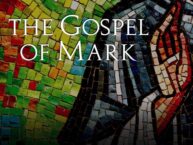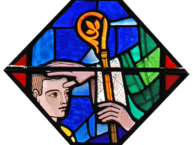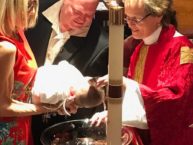
The Road to Emmaus by Daniel Bonnell
April 23, 2023: May God’s words be spoken, may God’s words be heard. Amen.
Happy Easter everyone! Yes – still Easter. In fact, while we celebrate Eastertide for 50 days, in reality we are always a resurrection people.
And today we get my favorite of the early resurrection experiences of the first followers of Jesus, and it is in my favorite of the four canonical gospels too – the Gospel of Luke. The story begins with Cleopas and his companion walking from Jerusalem to Emmaus, comforting one another in their deep grief over the death of their teacher and friend, Jesus.
Now, before we go any further, I want to remind everyone about the identities of these two folks. How many of you just assume that these are two men walking on this road? Those of you who have been here awhile know this already, but that assumption is a reflection of our society, not the scriptures.
The text says “Now on that same day two of Jesus’ disciples were going to a village called Emmaus, about seven miles from Jerusalem, and talking with each other about all these things that had happened.” Nowhere does it say these were two men! The Greek is gender neutral. Given that the bible is rife with examples of women going unnamed, and given that the bible authors have no problem usually telling you the names of every single man in the story, it is far more likely that it is a woman with Cleopas, not a man. This is not just my own opinion, of course, but that of many scholars who argue as much.
So, there you have it – Cleopas was walking the road to Emmaus with his wife, girlfriend, sister, female best bud., wing woman… Now that we have that cleared up, let’s go back to the story, because as our seminarian, Jackie, pointed out last week – resurrection is about story – about moving through the experience – and this is one passage that really makes this point very clear.
Cleopas and…well, let’s give her a name…how about Lilly, since it is Eastertide. Anyway, when Cleo and Lilly are walking along, Jesus comes alongside them on the road. We are told that “their eyes were kept from seeing him.” How is that possible? How could they not see the person they were grieving standing right before them. Well, according to psychologists, the same happens to us all the time.
There have been many studies on this phenomenon. In fact, there is a famous experiment about this very thing I told you about many years ago. “The phrase, “the invisible gorilla,” comes from an experiment created many years ago to test selective attention.” And yes, selective attention is a thing, and not just something your spouse accuses you of from time to time.
Anyway, in the study, participants are asked to watch a video in which two teams, one in black shirts and one in white shirts, are passing a ball. The participants are told to count how many times the players in white shirts pass the ball. Mid-way through the video, an actor in a gorilla suit] walks through the game, stands in the middle, pounds his chest, then exits. After watching the video, study participants are asked, “did you see the gorilla?” More than half the time, subjects miss the gorilla entirely.
So it is clear that we humans just don’t always see the things we think we would – what is right in front of our eyes.
Back to Cleo and Lilly… Jesus asks “Soooo, what’s up?”
Now, it might be hard to understand how that question lands with these two, but imagine if, let’s say, it is on the evening of 9/11 and you are walking in Manhattan and somebody asks you why you seem a bit out of sorts – what’s up? Or it is April of 2020 and somebody asks a nurse in the ER that same question. How would you react?
So, they explain to Jesus all that happened in Jerusalem and how devastating it all was to those, like Cleo & Lilly, who had hoped that Jesus was the long awaited Messiah. Now, wouldn’t that be a great time to do the big reveal? You know, “Hey Cleo and Lilly…Surprise! It’s me – Jesus!” Drop that mic Christ!
Well, that would have been really cool, but Jesus instead tries to help them understand why these things needed to take place. The living Word feeds them the living Word. And still they did not yet know it was Jesus. Then, the story takes an interesting and important turn.
It was nearing sundown, and Cleo and Lilly begin to make their way to lodging for the night in the village they had been walking toward from Jerusalem. It may have even been where they live, or it may be a place they knew they could lodge for the night – the text doesn’t make that clear. Jesus starts to continue on until Cleo and Lilly implore him to stay with them. They knew it was dangerous for a traveler on the road at night, and being good and faithful Jewish people, they also understood the commandment to welcome the stranger. So, they invite Jesus to stay with them. They invite Jesus in.
As they begin to eat the evening meal, in a twist of societal norms for the times, Jesus the guest acts as host at the table. He breaks the bread, and their eyes were opened in that moment – they recognized him. They recognize him in the breaking of the bread – and then, he was gone.
If we step back a moment and consider all the resurrection appearances we have been hearing these past few weeks, you really have to wonder – what on earth (or heaven for that matter) did the risen Christ look like? I mean, not one of his followers – from Mary to Peter to Thomas to Cleo and Lilly – recognize Jesus when they first see him. Was it really a gorilla thing, or did the resurrected, not yet ascended, Jesus actually look different than his earthly form? You really have to wonder, right? Still, we will never really know, and I suppose it really doesn’t matter.
But another question we should ask is – why these three – Mary, Cleo, and Lilly – before Peter, or James, or John? That’s right – these three got a visit from Jesus BEFORE the main 11! It really makes you wonder. And yet, that’s another question we may never really have an answer for, but what we do know is that all of the resurrection appearances tell us something important.
Mary, whose great love for Jesus kept her standing at the cross, brought her to the tomb to care for his body, had her in the garden searching for him in her grief – to her Jesus came first.
Jesus next came to Cleo and Lilly, the despairing ones on the road, but only revealed himself when they invited this stranger in and shared a meal with him.
Jesus then came to his disciples, the ones who did not believe Mary, the ones who were hiding in fear, and they recognized him by his wounds.
This is why the stories of these resurrection appearances are so powerful for us, because the experiences of each person Jesus comes too is so very familiar. There are not too many people in this world, especially post-pandemic, who have not experienced grief, despair, hopelessness, or a feeling of being lost, alone, and afraid.
And even if you may not be feeling those things about your own circumstances at present, the news in the past couple of days alone has brought us all into the place these two in Emmaus must have been. It is unfathomable that just since the 13th of April, the world has been rocked by the news of Ralph Yarl, a child shot for being black while ringing the wrong doorbell; Kaylin Gillis, a woman shot and killed because the car she was in pulled into the wrong driveway; Heather Roth & Payton Washington, cheerleaders shot while trying to flee a man with a gun in a supermarket parking lot after one of them had accidently opened the suspects’ car door thinking it was their car; and William White and his 6 year old daughter Kinsley, shot while trying to retrieve their basketball from a neighbor’s yard.
Good God, when will our national nightmare of gun violence end?
When, Lord, will we value your human children more than we value weapons?
When, Jesus, will stop hating the stranger and welcome them instead?
We now walk our own long road from Jerusalem, where we experience the Christ crucified today – the children executed on the rough wooden cross of hate, anger, fear, and our idolatry of gun worship.
We walk along wondering what happened?
How could this be?
Where is our God in whom we placed our trust?
That is why the story of these two on the road to Emmaus is a human story, our story. And thankfully, this and all of these resurrection experiences offer us what we need in this painful moment too, because they remind us of where we will find Christ today.
He will come to us in our deepest grief.
He is found in the wounded ones – the ones crucified by our hate, arrogance, and neglect.
He is present with us here – at this very table – when we welcome the stranger and in the breaking of the bread.
The Gospel of Luke tells us a story about two people that is really a story of promise to those reading the gospel then and now: The promise that Christ is alive – and will meet us in our pain, in our spiritual questioning, and in our lives lived in his name. Everywhere we look, Christ will be – most especially in the stranger, the homeless, the poor, the marginalized, and the lonely. And if we are living what we believe, they will see Christ in each of us!
But the road to Emmaus is only part of the story!
If we stop there – the church stops there – the Good News stops there.
It is the road to Jerusalem that completes the journey!
In every resurrection appearance, there is also the being sent – the telling of the good news. Mary told the other followers, but they did not believe her. They in turn told Thomas, but he did not believe them. And now Cleo and Lilly tell them, and everyone understands because everyone has shared in the experience of the real presence of Jesus. They all then tell the world – as we have been hearing in the passages from the Acts of the Apostles.
And so – what about us?
Well, we too have experienced the real presence of Jesus like Cleo & Lilly, and we also must return to Jerusalem to share the good news.
How?
Well, you know, Jesus gathered followers because he knew that faith grows in the context of community. The same is true for each of us today – our faith in him grows in community – here with one another as we listen to the scriptures, and most especially in the real presence of Jesus as we share in the Eucharist.
That is why it matters to be present here – to come to this table – to receive him in the Eucharist! Because when we experience the real presence of Christ we are healed and given strength for the journey back to the proverbial Jerusalem – back to a place where Christ is crucified today.
So let us this Eastertide walk with one another in our grief and despair, fear and uncertainty, that arises out of all that is happening in our lives and in the world.
Let us invite Jesus, who is found in the stranger, the sick, the oppressed, the imprisoned, the lonely, the hungry, the poor – to abide with us.
Let us break bread together here at this table, receiving in mind, body, and soul, the real presence of our Lord and Savior, that we may be restored in spirit to share the good news of the risen Christ in those proverbial Jerusalem places where he is most wounded by our hate and neglect.
For that is why the resurrected Jesus returns for them, and for us.
That by his life, death, resurrection, and ascension, we might be transformed from despair into hope, from grief into joy, from death into life.
And by this we may become the people we were born to be – transformative agents of God’s unconditional love and grace – defeating for all time the crosses that crucify him today.
Amen.
For the audio, click below, or subscribe to our iTunes Sermon Podcast by clicking here (also available on Audible):
The Rev. Diana L. Wilcox
April 23, 2023
Third Sunday of Easter – Year A
1st Reading – Acts 2:14a,36-41
2nd Reading – 1 Peter 1:17-23
Gospel – Luke 24:13-35

